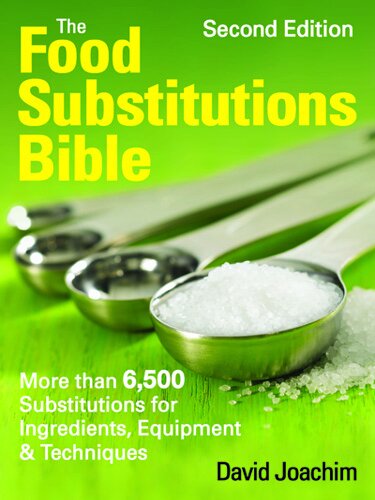 Book review – The Food Substitutions Bible, 2nd Edition. More than 6500 Substitutions for Ingredients, Equipment and Techniques by David Joachim Publisher: Robert Rose Inc. Toronto, Ontario, Canada 695 pages Price: $24.95 US
Book review – The Food Substitutions Bible, 2nd Edition. More than 6500 Substitutions for Ingredients, Equipment and Techniques by David Joachim Publisher: Robert Rose Inc. Toronto, Ontario, Canada 695 pages Price: $24.95 US
Publisher’s Summary:
Practical and enjoyable to read, this new edition of The Food Substitutions Bible has the best instructions for the home cook or professional chef who needs to find a great substitution when a vital ingredient is missing at a critical time in the preparation of a recipe.
Every substitution includes exact proportions and precise directions for making accurate, reliable replacements. Out of confectioner’s sugar? Finely grind half a cup plus one and a half tablespoons of granulated sugar with three-quarters of a teaspoon of cornstarch in a blender or small food processor.
This new edition features:
- More than 300 new entries and cross-references for ingredients, such as agave nectar, and equipment, such as a mandoline
- Five new ingredient charts and measurement tables, such as Picking Coffee, Container Size Equivalents and Alcohol Retention in Cooking
- 20 percent more content overall
- A bigger trim size to provide easier access to information
The straightforward page design makes each entry, chart and sidebar easy to understand and follow. This new edition is bigger, better, updated, expanded and completely revised, providing more information more readily.
The beginning cook, as well as seasoned ones, Occasionally run into a problem making a recipe and find they don’t have a perceived essential item. Many cooks know that buttermilk is not necessary in a recipe if one has a cup of milk with a teaspoon of an acid such as vinegar or lemon juice mixed in to replace the buttermilk. Other substitutions are not as obvious but are as simple.
David Joachim has compiled an encyclopedia of sorts for substitutions for not only ingredients, but techniques and equipment in the typical kitchen as well. The book is arranged in an alphabetic format so it is very simple to find the substitution your are trying to make. I like the fact also that if you normally call something by a brand name it will also refer you to the “ingredient” name and then offer substitutions. Each entry is also cross referenced like an index.
The book begins with a “how to use” section explaining in simple terms the best way to go about searching for a replacement and also flavor changes as well as straight replacements. There are also definitions and useful references as far as measurement quantities for the average use of the item such as collards 1 lb (500 gr) fresh = 1 1/2 – 2 cups (500 ml) cooked. It also has substitutions based on healthier options.
One substitution I immediately looked up was one for corn syrup. I know that corn syrup and HFCS are not the same, however, I have seen references in blog posts of some cooks wanting forego even the thought of using anything closely related so let’s see what Mr. Joachim has to say as far as a substitution:
It is not only listed as corn syrup but is divided into light or dark syrups. I’ll show you the reference for light corn syrup 1 cup. Sub with 1 1/4 cup (250 ml) of granulated white sugar and 1/4 (60 ml) cup of hot water or liquid from the recipe. or 1 cup (250 ml) golden syrup (sweeter) or 1 cup (250 ml) glucose Then he adds To change the flavor: Substitute 1 cup (250 ml) light corn syrup with 1 cup (250 ml) dark corn syrup, (adds caramel flavor and color) or 1 cup (250 ml) honey (sweeter and adds amber color) or 1 cup (250 ml) molasses (deepens flavor and adds darker brown color).
The back of the book is the part I liked best. The Ingredient Guide and Measurement Equivalents will become an invaluable resource for all. The simple act of picking an apple can be confusing at best. The ingredient guide gives you the flavor and texture components to allow you to choose the best apple for your recipes. He not only does this for apples but an exhaustive list of possible ingredients in most recipes. The sections are well described and not only gives a flavor profile, but an descriptive on color, shape and texture if needed.
The measurement equivalents includes equipment sizes as well as measurements of ingredients. There are also altitude adjustments, sugar temperature expectancies and even alcohol retentions in cooking.
There are also substitutions for equipment needs and technique needs. I did miss the fact that he didn’t know Gail Dosek’s (and many of our’s) replacement for the sifter as a nice bowl and a whisk, but I do think his book is exhaustive in trying to make a cooks life a bit simpler. From A1 to Zweiback Mr. Joachim has covered quite a bit! I recommend this book for beginning and seasoned cooks, and for the price they won’t be disappointed.

Hi Denise! Thanks for stopping by. You’ll love this book if you get it. There are so many different ways to use it. It will become a most grabbed book for certain.
This sounds like a really great book to have available in the kitchen. Food substitutions can be a lifesaver when you’re in the middle of cooking and just can’t run to the grocery store to buy a missing ingredient. Thanks for bringing this to your readers.